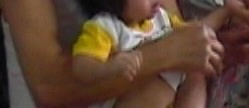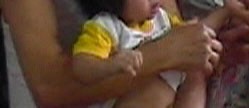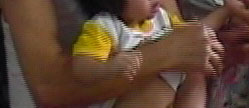+ Reply to Thread
Results 1 to 30 of 31
-
That is interlacing , you should not see this when you watch this on your TV. Cant tell a drop frame from an Image.
-
What is interlaced and non-interlaced video?
Interlaced video refers to video that is divided into two fields (upper and lower). Video standards that use interlacing are NTSC, PAL, and SECAM. In interlaced video, an image is drawn on the screen in two separate passes – in the first pass, the first field of information is drawn; the second pass fills in the remaining information for the second field. Non-interlaced video (also called progressive scan) displays video by drawing it on the screen in a single pass from top to bottom.
The United States standard is 30 frames per second video. The field rate will be double the frames per second, since two passes are made to draw each frame on the screen (30 frames per second = 60 fields per second). So, using this standard, interlaced video draws 60 fields of information on a video screen every second. PAL and SECAM standards both draw images at 25 frames per second (50 fields per second).
If you’re working strictly with digital video (for computer displays), then you won’t have to worry about field settings. Computers display video on a monitor as a sequence of complete frames (non-interlaced). So, video formats designed for computers don’t use fields.
It is possible to play interlaced NTSC video on both Windows and Mac computer systems. Likewise, you can play a progressive scan video clip on an interlaced (NTSC) video monitor, since interlacing is a characteristic of displaying and capturing video, not an issue related to file formats. Ideally, it is best to diagnose interlaced field-related issues on an interlaced video monitor, since doing so on a progressive scan monitor is unreliable. -
I can see (on tv) this after burning my DVD. I can even see this (minimal) from my DV file.Originally Posted by canadateck
I wonder if this cause by my DV transfer, how to avoid this? -
You shouldn't see interlacing after encoding and authoring to DVD so there may be something in your method that is causing it. What method and settings did you use to convert from DV .avi to DVD?
-
I use ulead dvd movie factory. Straight from DV to DVD using default settings.
-
There are 10 kinds of people in this world. Those that understand binary...
-
Possibly its de-interlacer is turned off, or just isn't working too well.Originally Posted by vocalmind
Any decent encoder will do the job. I use TmpGenc but CCE, Procoder, mainconcept etc all have their fans. Its largley a matter of learning how to set them up right for the source material.Originally Posted by vocalmindThere are 10 kinds of people in this world. Those that understand binary... -
Check at ULead. I know they had a MSP update that fixed a problem with reversing fields. To see if that is the problem try capturing a small clip "top field first" and then capture a clip of "bottom field" first and see which looks correct.
Check at http://www.ulead.com/tech/dmf/dmf.htm -
OK that was the key sentance.Originally Posted by vocalmind
Your video material is film and you are seeing the 3:2 (2:3) sequence used to display 24fps video in 30 (29.97) fps space.
Read this to understand
http://www.dvdfile.com/news/special_report/production_a_z/3_2_pulldown.htm
BTW: "drop frame" refers to adjustments to timecode required to make 29.9 fps video match a real clock in a broadcast environment. It has little application to amateur video. -
That sort of makes sense, apart from the fact the source for this was DV, which is 29.97fps. Unless of course its from a VCR or other source via DV passthrough I suppose.Originally Posted by edDVThere are 10 kinds of people in this world. Those that understand binary...
-
Could be, vocalmind needs to define the history of this video back to birth.
-
Okey guys,
The DV comes from a JVC miniDV camera, transfer through firewire (cheap card, OHCI compliant) by ulead visual studio. The PC is pentium 3, 1ghz with 384ram.
Actually I suspect that the problem is with the transfer because I tried transfering as the same time surfing the net then I had this result. It seems OK when transfer again but now closing background program and not touching the PC.
So I thought that this is a dropframe. If this is interlace, how could this comes up during transfer? I thought firewire transfer is only "transfer" not encoding.
My PC specs should be enough to do this firewire transfer, right?
I guess its already clear to you guys the issue. Appreciate your effort.
What should I do?
Thanks a million. -
It is true that the data can glitch during the transfer. This happens easily if the OS is sharing the disk controller and same hard drive as the transfer. Any background or forground tasks up the probability of a transfer glitch.Originally Posted by vocalmind
A data loss can be a few pixels on a line to a corrupted field or several fields. Remember several fields* can go by during a single disk seek. Data buffering may or may not be adequate to cover the gap.
Best to limit activity during transfer and/or if serious, use a separate disk and disk controller for video. The PCI bus mastering will keep video data flowing even while the OS is using its drive.
* a field takes 2 ms, a typical 7200 RPM drive has an average seek time around 8.5 ms. -
Thanks Guys,
I guess ill redo the transfer again. overnight when im sleeping, so I won't find the problem until everything is done.
overnight when im sleeping, so I won't find the problem until everything is done.
Is there any tools to detect this glitch? -
Transfer problems look totally different (big green spots/ distorted colors and such).For me, it looks like an interlaced Frame with wrong filed order before encoding.Try to play that part with VDub and deinterlacing filter.If all it's OK, try to encode with a different field order setting.
-
Ill try it later.Originally Posted by Dragonsf
BTW, what deinterlacing filter? whats different field order? Where can I find this settings?
Thanks again... -
1 sec / 60 fields per second = 16.7 ms.Originally Posted by edDV
1 sec / 50 fields per second = 20 ms. -
Interlaced frames consits of two fields.The ordering (timewise) comes in two flavours:top field first and bottom field first (PAL has normally bottom field first).During encoding it's important to know, which field comes first, because wrong order rendering produces sometimes flickering effects.
To test the field order, try the scripts - look for decomb -(AviSynth), which separate the fields and play them in any order.
Or use the VDub internal deinterlace filter. -
---Virtual Dub Requires a Video for Windows (VFW) compatiable codec to decompress video.---
I got this error[/quote] -
Right you are, it was late, but the point holds for single drive systems.Originally Posted by junkmalle
-

From Vdub with deinterlace filter [mode: blend]
Seems like the problem still there. Now I can confirm its the DV transfer problem.
BTW, VirtualDub detect my DV as type-1. Can this be an issue? -
You must have done something wrong. This is what blend mode deinterlace would look like in VirtualDub/MPEG/Mod:

The two fields are just blurred together. This looks a little worse than what you would get because I had to start with your JPEG image.
Here's what a drop field deinterlace, followed by a vertical resize looks like:

But you don't want to deinterlace in any way unless you are making a file only for use on a computer.
In all likelyhood you are not having any problems with your capture. Certainly, the "problem" in you picture is no evidence of dropped frames while capturing.
What your are seeing is simply interlaced video. Each frame of video from you camcorder contains two pictures, taken 1/60 of a second apart. All the even scanlines (one field) come from one picture, all the odd scanlines (the other field) come from the other. Anything that moved during that 1/60 of a second will give you those comb-like interlace artifacts. You should see those interlace comb lines when viewing the DV AVI file on the computer (unless you are using a player that deinterlaces on the fly). VirtualDub/MPEG/Mod does not deinterlace for the display.
If you are wondering why you don't normally see this on TV it's because you never see an entire frame on television. You see one field at a time. By the time one field is being drawn the previous field has faded away.
If you burn this video properly to a DVD, without resizing or deinterlacing, it will appear exactly the same as when you view the tape on your TV directly from the camcorder. -
vocalmind said
"I can see (on tv) this after burning my DVD."
"I still see this when using PowerDVD. "
also
"Actually I suspect that the problem is with the transfer because I tried transfering as the same time surfing the net then I had this result. It seems OK when transfer again but now closing background program and not touching the PC."
still a mystery.
Blurring fields or dropping a field tells us nothing new.
Those are ways to mask the defect. -
Yes, and the mystery is: how did vocalmind manage to screw up his perfectly fine DV capture when he converted it to MPEG and burned it to DVD.Originally Posted by edDV
-
If you force interlaced material into a progressive encode, this can happen. I've seen it.
Want my help? Ask here! (not via PM!)
FAQs: Best Blank Discs • Best TBCs • Best VCRs for capture • Restore VHS -
You mean ULEAD dvd movie factory default encode is progressive? I did not change anything on the GUI of ulead DVF.Originally Posted by lordsmurf
Ill re-do my transfer again. Ill let you know the result then.
Thanks a lot...
Similar Threads
-
jvc gy-hm 700 drop frame
By seistro in forum Camcorders (DV/HDV/AVCHD/HD)Replies: 3Last Post: 23rd Sep 2012, 13:31 -
Dazzle 720x 480 Frame Drop
By genericman in forum DVD & Blu-ray RecordersReplies: 0Last Post: 28th Mar 2011, 11:37 -
HDV Video >>>>> Use Non drop frame or drop frame and why?
By Canon GL-2 Guy in forum Newbie / General discussionsReplies: 7Last Post: 3rd Nov 2010, 19:30 -
Converting drop frame timecode to non drop frame timecode, and vice versa
By picrade in forum ProgrammingReplies: 1Last Post: 1st Mar 2008, 05:22 -
Frame drop in firewire HDV transfer
By Dinu Bandyopadhyay in forum Camcorders (DV/HDV/AVCHD/HD)Replies: 17Last Post: 19th Oct 2007, 12:29






 Quote
Quote